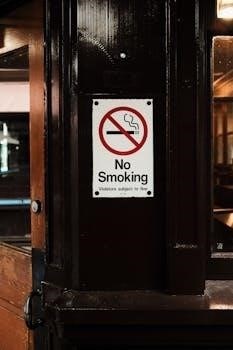Inside zone blocking is a fundamental run scheme in football‚ known for its simplicity and versatility. It emphasizes vertical displacement at the line of scrimmage‚ enabling consistent gains. This system allows for misaligned defenders to be accounted for.
What is Inside Zone Blocking?
Inside zone blocking is a running play where offensive linemen block designated areas‚ rather than specific defenders. The primary goal is to achieve vertical movement‚ creating space for the running back. Linemen are responsible for their playside gaps‚ aiming to displace defensive players. It’s a versatile scheme used at all levels of football‚ valued for its simple rules and adaptability against varied defensive alignments. This blocking scheme allows offensive linemen to use the defender’s movement and angles against them‚ sealing them off and creating running lanes.
Basic Principles of Inside Zone Blocking
The core of inside zone blocking revolves around vertical displacement and using defender’s angles. Linemen aim to move defenders off the line‚ creating running lanes by leveraging defensive movement.
Vertical Displacement Goal
The primary objective of inside zone blocking is to achieve vertical displacement of defensive linemen. This means moving the defenders straight back from the line of scrimmage‚ creating running lanes directly upfield. The goal is not to push defenders sideways but to generate push and create space for the running back. This vertical movement allows the running back to make a decisive cut and gain yards. By pushing the defensive line back‚ the offensive line creates opportunities for the running back to find open spaces.
Using Defender Movement and Angles
Inside zone blocking leverages the movement and angles of defensive players against them. Offensive linemen use the defender’s momentum to their advantage‚ sealing them off from the play. Linemen don’t need to overpower‚ but rather redirect defenders. If a defender moves one way‚ the blocker uses that movement to secure the block. This approach allows offensive linemen to use the defender’s aggression against them. This technique is a key principle to execute the inside zone effectively‚ creating running lanes by using the defenders’ choices to the offensive lines’ advantage.

Inside Zone Blocking Rules for Offensive Linemen
Offensive linemen in inside zone blocking are responsible for their playside gaps. They aim for vertical movement‚ using double teams when necessary and adjusting to defender alignment‚ ensuring no one crosses their face.
Blocking Playside Gap
In inside zone blocking‚ the primary responsibility of an offensive lineman is to secure their playside gap. This means they must engage any defender aligned in that gap‚ aiming to displace them vertically off the line of scrimmage. If no defender is present in the playside gap‚ the lineman takes a replacement step‚ looking to assist with a double team on a nearby defensive player. This rule ensures each gap is initially accounted for‚ and the lineman doesn’t leave a free run for the defense. The focus is always on creating movement forward‚ for the running back.
Double Team Techniques
Double teams in inside zone blocking are crucial for displacing defensive linemen. Typically‚ the playside guard will initiate contact with the defender‚ aiming for vertical movement. The adjacent lineman‚ often the tackle‚ will then join to create the double team. The goal is to drive the defender off the line of scrimmage‚ with one lineman eventually taking over the block. If a linebacker blitzes or the defender moves in a way that prevents the double team‚ it will be aborted‚ with each lineman handling their immediate threat. The fundamental principle is to prevent any defender from crossing their face.
Handling Defensive Linemen Alignment
Inside zone blocking is designed to handle various defensive line alignments through simple‚ adaptable rules. If a defensive lineman is lined up directly in front of an offensive lineman‚ that lineman will block him. If no defender is present in their playside gap‚ the lineman will take a replacement step and look to help on a double team to the backside. The key is for offensive linemen to use the movement and angles of the defenders against them‚ sealing them off from the play. No matter where a defender aligns‚ he will be accounted for.
Variations and Adaptations of Inside Zone Blocking
Inside zone blocking has several variations‚ like the inside zone slice‚ and unique approaches‚ such as Ferris State’s fast-paced system. These adaptations cater to different offensive strategies.
Inside Zone Slice
The Inside Zone Slice is a variation that adjusts the standard blocking scheme‚ often incorporating a different angle of attack. Though it is not the base inside zone‚ the 90/50/10 rule can be applied to the defensive line movements. This adaptation shows how offensive linemen approach blocking given the various defender alignments. This shows the versatility within the inside zone concept and how it can be modified to create different running lanes and opportunities for the running back to make plays.
Ferris State’s Unique Approach
Ferris State employs a distinctive inside zone blocking scheme‚ differing from the norm due to their fast-paced offense. Their approach necessitates simplified rules that allow for quick execution. Unlike other teams‚ Ferris State may not adhere to the standard blocking rules‚ prioritizing speed and efficiency. This system showcases how adaptability within the inside zone framework is key‚ demonstrating that the core concept can be modified to suit different offensive styles and tempos.

The Running Back’s Role in Inside Zone
In the inside zone‚ the running back’s role involves reading the block of the first down lineman outside the center. They aim to cut off the block and attack the line of scrimmage;
Reading the Block
The running back’s primary responsibility in the inside zone scheme is to read the block of the first down lineman outside the center. This crucial read determines the back’s path. If there’s space in the ‘B’ gap‚ that’s where the ball should go. The back aims to cut off the guard’s block‚ not necessarily running to the edge. This allows them to make a decisive cut based on the defensive movement and exploit available gaps. Proper reading ensures the play’s success.
Cutting off the Guard’s Block
In the inside zone‚ the running back’s path is defined by cutting off the outside hip of the guard. This differs from outside zone where the back runs towards the edge. Instead of aiming for the perimeter‚ the back aligns their movement to the guard’s block. This approach allows for a quick change in direction based on the defensive alignment. The back’s cut is a reaction to the created space‚ which ensures they are capitalizing on the offensive line’s efforts. This technique is key for consistent gains.

Common Issues and Solutions
Inside zone blocking faces challenges like misaligned defenders and broken double teams. Simple rules help account for defensive shifts‚ and linemen are taught to not allow defenders to cross their faces.
Handling Misaligned Defenders
A key advantage of inside zone blocking is its ability to handle misaligned defenders. Unlike other schemes‚ the zone approach uses simple rules that account for any alignment. Linemen block the defender in their playside gap‚ irrespective of their initial position. This adaptability ensures that no matter where a defender lines up‚ they will be accounted for‚ making it a versatile and reliable blocking scheme. The system uses the defender’s movement and angles against them. This method prevents a defender from crossing a lineman’s face and disrupts the defensive line.
When Double Teams Break Down
Double teams in inside zone blocking can break down due to defensive movement. If a defensive lineman moves to a position where only one offensive lineman can reach him‚ the double team is off‚ and the closest lineman will engage. Similarly‚ if a linebacker blitzes after the snap‚ the double team is also disengaged‚ and linemen adjust to their individual blocking assignments. The rule is to prevent any defender from crossing the lineman’s face. This adaptability ensures that even when double teams fail‚ the blocking scheme remains effective by accounting for all defensive players.

Teaching Inside Zone Blocking
Teaching inside zone involves simplifying rules for all levels‚ focusing on fundamental principles. Emphasis is placed on vertical displacement and using the defender’s movement against them for effective blocking.
Simplified Rules for All Levels
Inside zone blocking can be taught using simple‚ consistent rules‚ adaptable to all levels of play‚ from youth leagues to professional football. The core principle revolves around each offensive lineman being responsible for blocking their playside gap‚ focusing on creating vertical movement at the line of scrimmage. The simplicity of these rules ensures that misaligned defenders are accounted for‚ making it a versatile scheme for any team. This approach allows players to easily grasp their blocking assignments‚ leading to more effective execution on the field.
Emphasis on Fundamental Principles
When teaching inside zone blocking‚ emphasizing fundamental principles is crucial for success. These principles include achieving vertical displacement‚ utilizing defender movement and angles‚ and executing proper double team techniques. Offensive linemen must understand how to use the defender’s momentum against them. A key concept is ensuring no defender crosses their face. Furthermore‚ consistent execution of these core principles leads to a more effective and adaptable inside zone running game‚ allowing for consistent gains on the field. These fundamentals are the cornerstone of any successful inside zone play.
